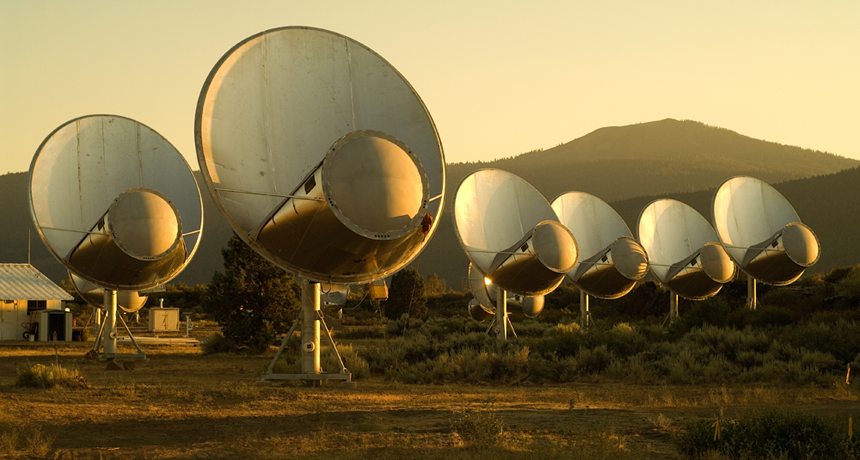Life beyond Earth
Are we alone? Scientists search for an extraterrestrial answer

In northern California, these satellite dishes listen for a message from aliens. They’re part of the Allen Telescope Array.
Seth Shostak
If aliens ever sent us a message, scientists hope to pick it up in a remote part of northern California.
There, in a clearing nestled amid the volcanoes of the Cascade Range, 42 radio dishes point together at the sky. The dishes, each 20 feet across, form a single, giant scientific instrument called the Allen Telescope Array. Scientists built the array to receive radio signals — the sort of message that could answer a very important question: Are we the only intelligent life in this vast universe?
“It’s a question humans have been asking forever,” observes astronomer Jill Tarter. Until recently, she directed the SETI (Search for Extra-Terrestrial Intelligence) Institute in Mountain View, Calif. “We read these ancient texts, and the ancient Greeks, the Romans, the Chinese — they were all wondering how we humans fit into the universe.” The SETI Institute helped build the Allen Telescope Array in hopes of finding some answers.
While the question is ancient, our understanding of the universe has changed over the centuries. We now know that stars do not hang from the sky like fruit on a tree. We also know Earth orbits the Sun and not the other way around. But we still don’t know if life exists elsewhere. And if extraterrestrial life does exist, does it have the technology to communicate with us on Earth?
If so, the Allen Telescope Array is listening, day and night, for some signal. From time to time, the dishes pivot toward a new patch of the sky. The array has not yet picked up any alien calls. So far, intelligent life appears limited to Earth.
But that has hardly frustrated scientists. The search for life elsewhere in the universe continues to prove irresistible to experts in a wide variety of fields, from biology to astronomy, and from psychology to computer science. And they’re not just looking for aliens that can communicate: Many researchers suspect that simpler, microscopic alien life might be lurking on some distant planet.
Even if their quest has yet to turn up any aliens, it has led to some surprising discoveries — including some right here on Earth. If anything, the search for extraterrestrial life has become a lot more exciting. Perhaps it’s just a matter of time until we discover we’re not alone.
Life, unexpected
In 1960, astronomer Frank Drake (father of Science News writer Nadia Drake) was among the first to listen for extraterrestrial radio signals. That was decades before anyone knew whether any aliens out there even had a place to call home. We now know they might, thanks to discoveries since 1995 of planets outside our solar system.
To date, astronomers have found hundreds of these far-off worlds, called exoplanets. Some scientists predict hundreds of billions more exoplanets await discovery in our galaxy, the Milky Way. It’s easy to imagine there must be life on at least one of those planets. And if not there, perhaps life thrives on some moon orbiting one of those planets.
“Some may be at the right temperature where liquid water might exist. And that’s necessary for life as we know it,” says Tarter.
The discovery of so many new worlds, most of them found by the Kepler space telescope, has helped narrow the search for aliens. Tarter says the Allen Telescope Array now points at stars Kepler has flagged as having planets. Astronomers elsewhere in the United States and abroad have joined the hunt for life elsewhere in the universe.
Scientists searching for extraterrestrial life aren’t just looking up. Biologists, who study life in all of its forms, have joined the search too. They peer down into some of Earth’s most unfriendly places to find tiny but tough organisms called extremophiles (ex TREEM oh fylz). For more than 50 years, scientists have found extremophiles in places where life wasn’t thought to be possible.
Some of these microbes live in the acidic sulfur springs of Yellowstone National Park. Some thrive near cracks in the ocean floor — called hydrothermal vents — that spew scalding water. Others flourish in cracks in the ice in Antarctica, or deep underground in mines.
The discovery that life on Earth can survive under such harsh conditions has broadened the understanding scientists have of where they might find life off Earth.
“By learning more about the boundaries of life here on Earth, we can improve our definition of what life is and what it can tolerate,” says Jamie Foster. This biologist at the University of Florida studies extremophiles. “It’s really important to turn over every rock and look in every environment,” says Foster. “The envelope of life keeps getting bigger and bigger with the discoveries of life in these extreme environments.”

Extremophiles on Earth suggest that scientists may not have to study some distant star to find evidence of extraterrestrial life. They may not be intelligent, but single-celled life-forms could be hiding relatively close by. Scientists point to one candidate site: Europa, a moon of Jupiter. It probably hides a vast, slushy ocean beneath its smooth, icy surface. Measurements also suggest it might host superhot hydrothermal vents — like those found on the floor of oceans on Earth.
“We know that life can exist here on Earth in that kind of environment, so it might be possible on Europa,” Foster says.
There is no immediate plan to send spacecraft off to find out. But later this summer, a NASA rover called Curiosity should arrive at Mars. It “will give us a really interesting clue as to whether Mars is potentially habitable now or possibly was in the past,” says Foster. “Most people think that if life exists on Mars, it’s probably under the surface.”
It will take future missions to explore the depths of Mars and Europa for signs of life. Meanwhile, the search for life continues to engage scientists in a surprising variety of ways. While some remain busy with the hunt itself, others are already thinking way ahead to the day we might make contact.
Speaking in numbers
“If we get a message from another civilization, it’s not going to be in English or Chinese or Swahili,” says psychologist Douglas Vakoch. He is director of Interstellar Message Composition at the SETI Institute. “What language do we have in common? The usual starting place is math and science.”
Math is sometimes called the universal language. Though people may speak very different languages in different countries, math works the same everywhere. If you have two rocks and scoop up three more, you end up with five — regardless of where you live. We all share the same basic rules of addition, subtraction, multiplication and division. Researchers like Vakoch argue that if the language of math can be understood among nations, then why not among planets?

If an alien civilization can beam a message across space, then it must have first created some kind of transmitter, Vakoch observes. Building a transmitter — or any instrument that sends energy through space — requires a lot of knowledge about math. And if that alien math really is the same as human math, then it offers us a way to communicate. So it is easy to imagine that the first message from aliens may consist of radio pulses that follow a mathematical pattern. For example, we may receive pulses in multiples of two: first two, then four, followed by six, eight and so on.
Vakoch tries to predict what an incoming alien message might look like. He also works with other scientists to determine what kind of outgoing messages we should send back. It might be useful to send pictures of human beings to other civilizations, for example, or to include information about biology and life on Earth.
“We’re looking for ways to communicate something that can be described in scientific terms,” he says.
That is just what some scientists have already done. On November 16, 1974, researchers led by Frank Drake transmitted a message from the Arecibo Radio Telescope in Puerto Rico toward a distant grouping of stars. The radio pulses followed a numerical pattern, encoding a sort of “introduction to Earthlings” for aliens. The message contained information about human beings, our counting numbers, the radio telescope and the solar system.
“The message was repeated a couple of times,” Vakoch says. “That’s one way to make sure it remains intelligible even if there’s some error in transmission.”
So far, there’s been no answer. But nobody expected one yet — the message will take about 25,000 years to reach its destination.
If and when a message from an alien civilization does arrive, it may come as a series of super-short bursts of light or as a packet of radio waves. Whatever the message’s form, it likely will have traveled for thousands or even millions of years across space — even if all it offers us is a brief “hello” from a civilization just as unsure about the universe as we are.
That uncertainty helps make the search for extraterrestrial life so interesting, says Tarter, who has spent 20 years studying ways to listen for aliens. In May, she changed gears, going from searching for alien signals to raising money for the institute. Listening for aliens offers endless opportunities for anyone curious about our place in the universe, she says.
“There are a lot of things we don’t know, and you may have the opportunity to figure them out,” Tarter says. “Science is about constantly asking ‘why’ and figuring out the answers to questions that nobody else has answered.”
She notes that any message — even a simple “hi” — would have enormous implications for all humans. A message will have to travel thousands, if not millions, of years to get from planet to planet. By the time we receive a signal, the civilization that sent it might not even exist any more, which means we might not make new alien friends.
But if we receive a message, Tarter says, “then we’ll know that it’s possible to survive all the problems we have created for ourselves, and work our way out of them. I can’t imagine anything more profound than learning that it’s possible to grow old as a civilization.”
Power words
radio wave An electromagnetic wave used for long-distance communication. Radio waves are longer than the waves of visible light.
extraterrestrial Anything of or from regions beyond Earth.
extremophile A microorganism that lives in conditions of extreme temperature, acidity, alkalinity or chemical concentration.
astronomy The study of stars, space and the universe as a whole.
exoplanet A planet that orbits a star outside the solar system.
hydrothermal vent An opening in the sea floor out of which heated, mineral-rich water flows.
Word Find (click here to print puzzle)








